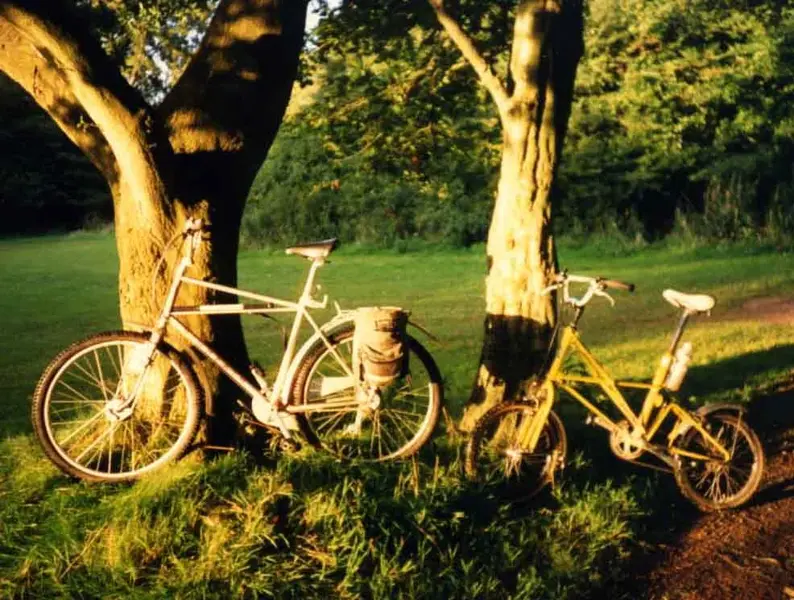You are using an out of date browser. It may not display this or other websites correctly.
You should upgrade or use an alternative browser.
You should upgrade or use an alternative browser.
Please educate me...what the eck is this
- Thread starter Harryburgundy
- Start date
one-eyed_jim
Old School Grand Master
Like a low budget Hanebrink:
http://www.hanebrink.net/
http://cgi.cafr.ebay.ca/ws/eBayISAPI.dl ... 0277516682
http://www.hanebrink.net/
http://cgi.cafr.ebay.ca/ws/eBayISAPI.dl ... 0277516682
one-eyed_jim
Old School Grand Master
Interesting - I didn't know there was a connection, but both companies seem to be based in Big Bear, California. Anybody know the story there?one-eyed_jim":1djq5lqg said:Like a low budget Hanebrink:
one-eyed_jim
Old School Grand Master
Too bad they don't get the mech up out of harm's way like this clever Whyte.chris667":1ci6zvz3 said:Rear mech is awfully close to the ground, though. Use a breakaway bolt!
The Burro's a bike where a Rohloff would make a lot of sense.
Attachments
much better - but I'd just worry about the seatpost snapping instead :shock:Too bad they don't get the mech up out of harm's way like this clever Whyte
one-eyed_jim
Old School Grand Master
One advantage of a small wheel is that the weight of a fat tyre and rim drops in proportion to the smaller diameter. You get the float and cushion of a fat tyre without the weight and clearance problems of a big diameter wheel.Xesh":3sf6fcqc said:WHY?
Lower than with a bigger wheel, obviously, but a 20" nominal (406mm) rim with a 3" tyre gets you a 22" diameter wheel, which makes an 88" top gear with 44:11. That's not a sprinting gear, but these aren't sprinting bikes.Also the gearing must be stupidly low.
I'd like to try one. Looks like fun.
Harryburgundy
Gold Trader
- Feedback
- View
one-eyed_jim":369wprcq said:Lower than with a bigger wheel, obviously, but a 20" nominal (406mm) rim with a 3" tyre gets you a 22" diameter wheel, which makes an 88" top gear with 44:11. That's not a sprinting gear, but these aren't sprinting bikes.Also the gearing must be stupidly low.
I'd like to try one. Looks like fun.
Same here...can see me plodding through the local woods on that....mmm...now what ratio for a singlespeed?
- Feedback
- View
Big wheel v Little wheel
These two bikes, both from 1988, show that the big wheel / small wheel ATB debate is nothing new.
The Moulton ATB is strong, accelerates quickly, and is multi-purpose.
The Highpath made Cleland, is designed for riding over soft rough ground with the minimum rolling resistance. It's large 650B x 2 inch tyres run at very low presure, are its secret.
On soft ground the Cleland is fast and efficient and the Moulton slow, as it digs a small trench as it moves. This feels like you're towing a plough behind the bike.
On smooth, hard ground, the Moulton is faster. It's perfect for road use with the occaisional off-road section. You do need to look out for wheel sized holes though.
In theory small wheels should not be as good for hill climbing as large ones. This is because there is a force vector from the rear axle (fixed point from the ground) that pushes against the centre of mass of the machine and rider. The steeper this vector the smaller the proportion of the total pedalling energy is actualy pushing the bike & rider up the hill. The remaining vertical component of the vector will then cause the front wheel to lift more easilly than with a large wheeled bike in the same gear.
Small wheels are of course inherently stronger and so can be made lighter.
These two bikes, both from 1988, show that the big wheel / small wheel ATB debate is nothing new.
The Moulton ATB is strong, accelerates quickly, and is multi-purpose.
The Highpath made Cleland, is designed for riding over soft rough ground with the minimum rolling resistance. It's large 650B x 2 inch tyres run at very low presure, are its secret.
On soft ground the Cleland is fast and efficient and the Moulton slow, as it digs a small trench as it moves. This feels like you're towing a plough behind the bike.
On smooth, hard ground, the Moulton is faster. It's perfect for road use with the occaisional off-road section. You do need to look out for wheel sized holes though.
In theory small wheels should not be as good for hill climbing as large ones. This is because there is a force vector from the rear axle (fixed point from the ground) that pushes against the centre of mass of the machine and rider. The steeper this vector the smaller the proportion of the total pedalling energy is actualy pushing the bike & rider up the hill. The remaining vertical component of the vector will then cause the front wheel to lift more easilly than with a large wheeled bike in the same gear.
Small wheels are of course inherently stronger and so can be made lighter.
Attachments
Similar threads
- Replies
- 9
- Views
- 376

